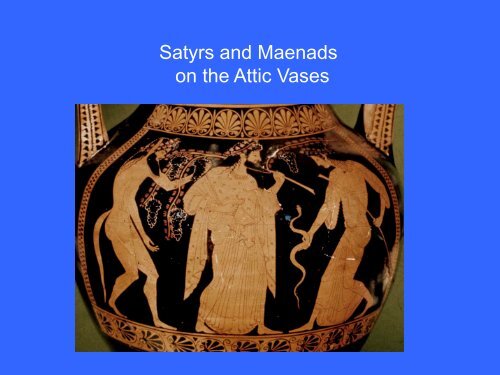You also want an ePaper? Increase the reach of your titles
YUMPU automatically turns print PDFs into web optimized ePapers that Google loves.
<strong>Satyrs</strong> and <strong>Maenads</strong><br />
on the Attic Vases
The theater at Epidauros in its<br />
present state dates to ca 350 BCE
The theater at Delphi as it is now seen dates to the 2 nd century BCE,<br />
but, as in the case of the theater at Epidauros, the general form has<br />
changed little since the 5 th century.
The theater of <strong>Dionysos</strong> at Athens occupies<br />
the site of a 6th century theater. It got a<br />
face lift in 330 BC when stone seats<br />
replaced wooden ones (the new seats<br />
included special seats for the priesthood,<br />
14 of which remain in place).
Right: a mask sits<br />
on top of an upended<br />
amphora.<br />
A tragic chorus (left) dances before an<br />
altar. A tragic actor holds a mask while a<br />
2 nd actor dances (below, left) and a mask<br />
lies on the ground before an actor who is<br />
securing his boot (below, right)
4 th century attic vase representing<br />
Orestes and Electra at the tomb of<br />
Agamemnon. Hermes (left) wears<br />
stage boots.
Comic actors, perhaps in a performance of<br />
Aristophanes’ “Birds” – the vase dates to ca<br />
4<strong>15</strong>-410 BCE.
Theater of <strong>Dionysos</strong> at Athens<br />
Stage, marble paving in<br />
the orchestra, and supporting<br />
sculpture (satyrs) belong<br />
to the Roman period.
Theater of <strong>Dionysos</strong> at Athens<br />
Stone seat for the Priest of <strong>Dionysos</strong><br />
faces the center of the orchestra where<br />
there was an altar to the god.<br />
Lying on the ground near the theater are<br />
various sculptures (Roman) including this<br />
beautiful satyr.
The Lysikrates Mt was preserved as part of<br />
a monastic retreat (illustration of 1830)<br />
The play was about the capture of<br />
<strong>Dionysos</strong> by pirates whom the god<br />
turned into dolphins (drawing of 1762)<br />
Coregic Monumnet dedicated by<br />
Lysikrates 334 BCE (he financed<br />
and trained the chorus for the victorious<br />
satyr play that the mt. commemorates).
Chorus of Aged <strong>Satyrs</strong>
Pronomos Vase<br />
C 400 BCE<br />
(Naples)
A satyr-play about <strong>Dionysos</strong> and<br />
Ariadne (the two central figures, left).
A satyr as Perseus (above)<br />
Perseus, carries off the head of Medusa<br />
A satyr as Hermes
Above: Oedipus and the Sphinx (500-<br />
475 BCE)<br />
Right: Satyr imitating Oedipus before<br />
the Sphinx (425-420 BCE).
Red figure satyrs, more apparently than black figure satyrs, imitate the<br />
everyday world of men – satyrs are not only playful but great mimics.<br />
Above left, a satyr plays the part of an Athenian craftsman (he is fluting a column).<br />
Notice the wine skin hanging behind him on the wall. Above, right, a true Athenian<br />
craftsman makes a helmet.
Above (left), a satyr-citizen<br />
Above (right), a satyr as pedagogue.<br />
Below (right): compare the real Athenian<br />
pedagogue (he is seated to the right)<br />
who waits while his charges have writing<br />
and music lessons.
A satyr, offering a rabbit as a love<br />
gift, courts a young man.<br />
A satyr makes an offering at<br />
a religious shrine. The deity is<br />
a “herm” – a pillar with the head<br />
of Hermes and a prominent<br />
phallos.
Satyr as warrior armed with phallos<br />
spear<br />
<strong>Satyrs</strong> as warriors in chariots (and as<br />
the horses that pull them).
Above (left) satyr as<br />
parent<br />
Above (center) satyr as<br />
athlete<br />
Below (center): satyr as<br />
musician
<strong>Satyrs</strong> are not only great mimics, but as part of their playful nature, they are also<br />
etremely curious. On the left, a satyr investigates the contents of a lidded box.<br />
Also consistent with their playfulness, satyrs are ever bold in their quest for an<br />
altered state of consciousness. On the right, a satyr has all but fallen into a large<br />
wine-storage jar (a “pithos”).
Once inebriated, satyrs are capable of amazing feats!
The Capture of Silenos
Hermes brings baby <strong>Dionysos</strong> to Silenos<br />
Phiale Painter Vatican Mus. 559
Red figure satyrs approach<br />
maenads with plainly sexual<br />
intent, but the moment of<br />
consummation is never shown.<br />
Here the satyrs assault a<br />
sleeping maenad on two sides<br />
of a kylix by Makron (480 BCE)
As during the 6 th century (on the black<br />
figure vases), red figure satyrs continue to<br />
engage maenads playfully – e.g., the game<br />
of blaind-man’s bluff (left). <strong>Satyrs</strong> also<br />
continue to carry off maenads without any<br />
Indication of resistance. This coin is<br />
from the Island of Thasos, 465-450 BCE.
Red Figure satyrs and maenads<br />
continue to dance in celebration<br />
of the god, <strong>Dionysos</strong> – again,<br />
without any sign of tension.
Vases like this amphora by the<br />
Kleophrades Painter (500-490 BCE)<br />
show satyrs dancing in harmony with<br />
their female counterparts.
In the 6 th century, on the black figure<br />
vases, satyrs are commonly autoerotic<br />
as on the aryballos by Nearchos, 570-<br />
555 BCE (left).<br />
On the red figure vases, satyrs are<br />
successful with mules and even with<br />
large amphorae (below)
Never, until this very late and unique<br />
example, does a satyr consummate his<br />
desire with a woman.<br />
This detail is from a vase by the Jena<br />
Painter from about 390-380 BCE.
<strong>Maenads</strong> sometimes appear without their satyr<br />
companions, but most often maenads and satyrs<br />
appear together in Dionysian thiasos.
Above (left): satyrs crush grapes and<br />
store the wine for the festivities above<br />
their heads (Amasis Painter)<br />
Aove (right): satyr curshes grapes,<br />
another dances with a maenad as<br />
<strong>Dionysos</strong>, kantharos in hand, looks<br />
on (Amasis Painter)
Right: satyrs accompany <strong>Dionysos</strong> in<br />
in a Black Figure Return of Hephaistos<br />
(Oakeshott Painter 550-520 BCE)<br />
Below: Return of Hephaistos on the<br />
Francois Vase (ca 570 BCE)<br />
Left: <strong>Maenads</strong> and satyrs dance<br />
around <strong>Dionysos</strong> and Ariadne<br />
in traditional Black Figure “thiasos”<br />
(Oakeshott Painter ca 550 BCE)
<strong>Satyrs</strong> and <strong>Maenads</strong> consort harmoniously during the<br />
6 th century on all the black figure vases. Above, they<br />
dance arm in arm. They may even be found in the<br />
Rare instance face to face, lips puckered (frag “A”<br />
above, and also on the Dayton Painter ‘s vase, right,<br />
530-525 BCE).<br />
A<br />
<strong>Satyrs</strong> are from the<br />
beginning playful (see<br />
frag, above, where<br />
they mimic the mule’s<br />
pose).
Satyr pursues maenad with<br />
amorous intent<br />
Satyr’s pursuit ends in mid-air<br />
Collision – <strong>Dionysos</strong> looks on.
Marriage involved a public<br />
procession from the house of<br />
the bride to that of the groom …
… but, as in the vase representation of the warrior’s departure (right), so on many of<br />
the Attic grave stones (“stele”), the wife’s head and eyes are lowered before<br />
her husband.
Women are represented as<br />
playfully childish, juggling and<br />
playing ball…
… and in this instance, riding a tetter-totter.
She cared for the children<br />
(in well to do homes, she was<br />
assisted by female servents),<br />
and she did the cooking (below<br />
right).
Scenes from a cup by<br />
the Brygos Painter (Florence)
The Kleophrades<br />
Painter’s vase introduces a<br />
group of vases, made between<br />
about 500-450, that suggest<br />
tension between the satyrs and<br />
the maenads.<br />
The “thyrsos”, a vine tipped wand<br />
carried by nearly all red figure<br />
maenads, seems to be used in<br />
these scenes as a weapon<br />
directed at the satyr’s groin.<br />
Above, the satyr seems to<br />
struggle with the maenad for<br />
possession of the “thyrsos”.
The horizontal tilt of the “thyrsos” seems<br />
to be no more than a compositional<br />
device in the friendly encounter at<br />
the upper left, but there are too<br />
many other scenes in which the<br />
maenad aims her wand at the satyr’s<br />
groin to be merely a function of the<br />
composition (all of these examples,<br />
are cups by the painter Makron c. 480<br />
BCE).
There can be little doubt that on<br />
krater (detail above) by the Goluchow<br />
Painter (ca 500) real combat is depicted,<br />
and that on the cup (right) by Douris (500-<br />
490) that the satyr is genuinely terrified.
On the Pig Painter’s krater (460-450), the violence of<br />
the satyr’s pursuit is underscored by the overturned<br />
amphora beneath his feet, and the seriousness of the<br />
maenad’s defense is suggested by the snake she<br />
extends toward the pursuing satyr.
During the 5 th century, many satyrs<br />
with erect phalloi pursue maenads,<br />
but, on many other vases like these,<br />
the satyrs become “gentlemen” where<br />
the scenes are not pursuits and the<br />
phalloi are not erect.<br />
Both of these are probably scenes<br />
of ritual where the satyr replaces<br />
an Athenian male citizen.
Finally, on this krater by the Methyse Painter (ca 450<br />
BCE), a diminutive satyr appears. He is clearly fearful<br />
as he looks up at the cold stare of the maenad who follows<br />
and he clings tightly to the leg of <strong>Dionysos</strong>.
This diminutive satyr (left) plays<br />
the part of a servant who props<br />
up a man too drunk to walk on<br />
his own. Following is an even<br />
smaller satyr carrying a torch (?)<br />
and a small jug.<br />
The use to which the pitcher<br />
was put in the scene above<br />
may come to mind.
The dismemberment of<br />
Pentheus by maenads<br />
Euphronios, late 6 th century (right)<br />
A vase in Berlin by an Unknown<br />
Painter

















